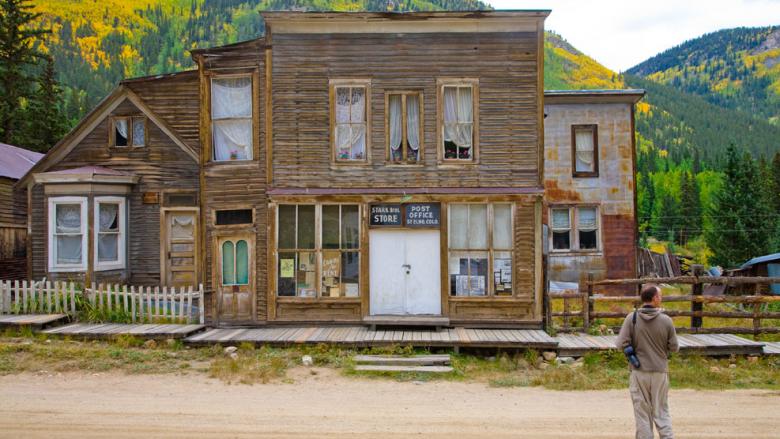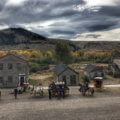Boom And Bust: The Authentic Old West Ghost Towns Of Colorado
Colorado is home to 150 recorded town sites and many more abandoned or ghost towns with storied pasts of mining riches, rowdy saloons and outlaw showdowns. Walk these main streets and imagine the former hustle and bustle of these towns in their heyday during Colorado’s mining boom frenzy in the late 1800s. Here are some of Colorado’s best-preserved and most accessible ghost towns for modern-day visitors to take take a peek at the Old West.
Animas Forks. In 1873, explorers discovered deep deposits of gold and started building Animas Forks in southwest Colorado, which sits at an elevation of 11,160 feet. Some 400 to 1,000 people called Animas Forks home, but the town’s extremely harsh conditions meant residents didn’t stay for very long. Local lore claims Evalyn Walsh, mining heiress and owner of the Hope Diamond, penned her autobiography in this town. Visitors are advised to reach Animas Forks in the summer via a four-wheel drive vehicle or rent an ATV in nearby Lake City or Silverton.
Ashcroft. The discovery of silver in 1880 lurched Ashcroft into its peak as a bustling mining camp that was home to more than 1,200 people before going bust in 1885 after the shallow silver deposits had been depleted. Once home to 20 saloons, Ashcroft residents abandoned the town and moved their houses down the road 10 miles to Aspen. More than a dozen original buildings still stand today, most along the main street, including the jail, livery stable, the old hotel and several saloons. A $3 donation is suggested to visitors to continue to preserve the town.
Boggsville. Thomas O. Boggs founded Boggsville in 1862 in southeast Colorado with his sights set on a booming town with the addition of a railroad, but the population never grew past a few dozen. It flourished to be the center of trade, agriculture, education and culture, and was a crucial stop along the Santa Fe Trail. The women of Boggsville were known for creating an enclave of elegance and beauty in the midst of a harsh western landscape. Boggsville was also made famous as the last home to famed frontiersman Kit Carson. The 19thcentury settlement offers free admission and customized tours of the renovated buildings. On this self-guided tour, visitors may run into birders along the Purgatoire River or archaeology students in a field school.
Carson and Old Carson. The sites of Carson and Old Carson are two seemingly undiscovered former mining towns. At nearly 12,000 feet along the Continental Divide, the harsh winters were unpopular with miners. Access Carson from Lake City on Wager Gulch Trail via 4×4, bike or hike on the east side of the divide, and then head west to discover Old Carson.
Dearfield. East of Greeley in northeast Colorado, the only all-black settlement was home to more than 700 African Americans in the early 1900s. Dearfield represents the national Black American colonization movement established for promoting self-sufficiency and land ownership. The town didn’t survive the Great Depression and Dust Bowl years, though three buildings remain today: a gas station, diner and the founder’s house. Visitors can access Dearfield by driving along CO 34 east from Greeley for about 25 miles and will be directed via a marked sign.
Independence. Nestled along the hairpin turns of the stunning Independence Pass that connects Aspen and Leadville, Independence was formed after gold was discovered at the head of Roaring Fork River in the early 1880s. What remains of the town can be found about two miles from the pass summit. The Aspen Historical Society offers tours of the boom and bust town that miners abandoned on wooden skis made from the log cabins in 1899.
Montezuma. Situated above Keystone Resort in Summit County, Montezuma was founded in 1865 after the discovery of silver. Nearly 1,000 people resided in this scenic mining camp during its height. Visitors will find a general store, schoolhouse and private homes still standing today.
Pitkin. Northeast of the Gunnison/Crested Butte area is one of the largest collections of remaining buildings of any ghost town in the state. Established as a mining camp in the 1870s, Pitkin was a substantial town that grew to 1,000 residents and 200 structures, including 12 saloons and eight restaurants by 1880. A harsh winter drove residents away, but miners returned in droves the following spring, ballooning to an estimated population of 4,000. Travelers will discover a beautifully restored community church, store and a number of private homes, all set against the picturesque backdrop of snow-capped peaks and grassy meadows.
St. Elmo and Tin Cup. One of Colorado’s best-preserved – and most easily accessed – ghost towns is St. Elmo, just west of Buena Vista. The beginnings of the town were first constructed in 1878, and St. Elmo’s economy relied on both freighting and mining. Wooden storefronts and a dusty main street comprise what remains today as a quintessential ghost town. It is easily accessed via car, but visitors can also rent ATVs at the general store and make the trek to nearby Tin Cup, where the tales of this rowdy town linger in the town cemetery.
Teller City. Located in the northwest corner of Colorado, Teller City is a true ghost town that has been completely abandoned. Within just 20 years, the silver-mining camp boomed with hundreds of log cabins and almost 30 saloons that were later deserted entirely. Several cabins and artifacts remain along a three-quarter-mile trail for visitors, and panning for gold in the nearby streams may yield a few golden flakes.
Tomboy. High above Telluride and below Imogene Pass sits Tomboy, where 900 residents once called home until the ore at the Tomboy Mine ran dry. Accessible during the summer months, visitors will pass through the “Social Tunnel,” where single women and Tomboy Mine men would meet each other for “social” time. Take a Jeep tour with a local outfitter or mountain bike into Tomboy from Telluride.











